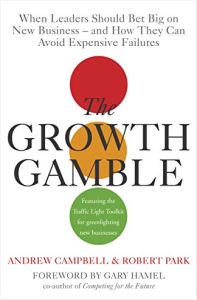Join getAbstract to access the summary!

Join getAbstract to access the summary!
Andrew Campbell and Robert Park
Growth Gamble
When Leaders Should Bet Big on New Business - and How They Can Avoid Expensive Failures
Nicholas Brealey Publishing, 2005
What's inside?
Find out how you can keep your corporate growth initiative from going the way of 99% of new businesses: down the tubes.
Recommendation
Some senior executives are so eager for growth that they gamble their company’s riches on new business initiatives that will probably fail. Researchers estimate that the failure rate for company-spawned business initiatives is as high as 99%. Authors Andrew Campbell and Robert Park tell companies to be selective about which growth opportunities they pursue – even if that means standing pat and accepting low growth. Growth, they say, is simply not possible at all times for all companies. They provide valuable tools, including a "traffic light" evaluation filter and a "confidence check" mechanism, to help you choose and execute new business endeavors. Wall Street has almost no greater profanity than "low growth," but if you take seriously your fiduciary duty to spend shareholders’ dollars wisely, you should read this book. The time has come for a sober, systematic approach to growth.
Summary
About the Authors
As a director of Ashridge Strategic Management Center, Andrew Campbell consults with several major corporate clients. He also serves as a visiting professor at City University and was a fellow in the Center for Business Strategy at the London Business School. He’s a Harvard MBA who worked for six years at McKinsey & Co. Robert Park, also an independent consultant, has a quarter-century of banking experience.

















Comment on this summary